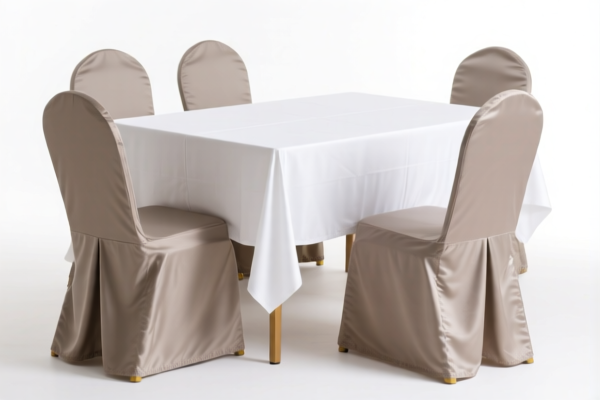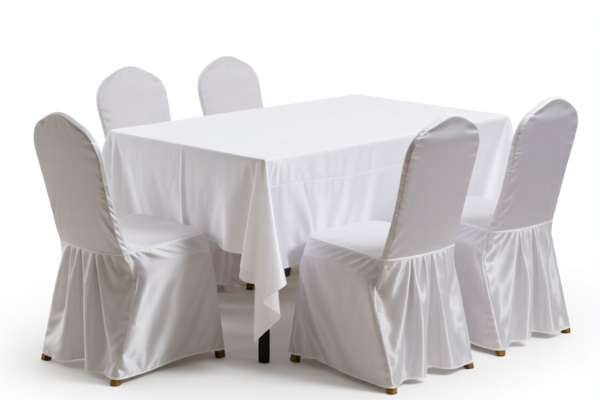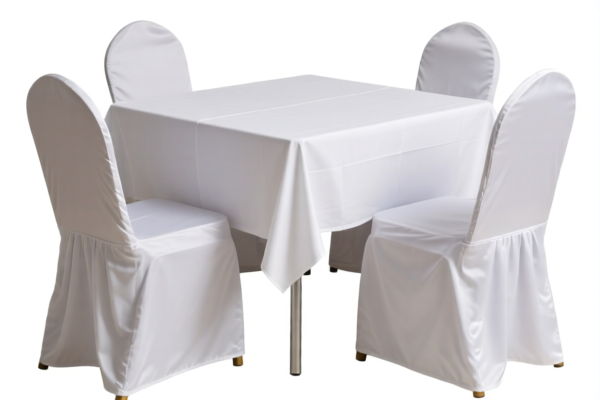| HS Code | Official Doc | Tariff Rate | Origin | Destination | Effective Date |
|---|---|---|---|---|---|
| 4205008000 | Doc | 55.0% | CN | US | 2025-05-12 |
| 4205000500 | Doc | 57.9% | CN | US | 2025-05-12 |
| 3918105000 | Doc | 59.2% | CN | US | 2025-05-12 |
| 3918905000 | Doc | 59.2% | CN | US | 2025-05-12 |
| 3919905060 | Doc | 60.8% | CN | US | 2025-05-12 |
| 3919905040 | Doc | 60.8% | CN | US | 2025-05-12 |




Table Cover
A table cover, also commonly known as a tablecloth, is a cloth or plastic spread placed over a table to protect its surface and/or for decorative purposes.
Material
Table covers are manufactured from a wide variety of materials, each offering different characteristics:
- Cotton: A natural fiber, cotton tablecloths are durable, washable, and offer a classic look. They are prone to wrinkling and staining.
- Linen: Considered a premium fabric, linen is strong, absorbent, and develops a desirable softness with use. It is more expensive than cotton and requires more careful maintenance.
- Polyester: A synthetic fiber, polyester is wrinkle-resistant, stain-resistant, and affordable. It is less breathable than natural fibers.
- Vinyl/PVC: Waterproof and easy to clean, vinyl tablecloths are ideal for outdoor use or messy situations. They lack the aesthetic appeal of fabric covers.
- Oilcloth: A traditional material made of cotton or linen coated with linseed oil. It's durable, waterproof, and has a vintage look.
- Acrylic: Offers a silk-like appearance with good resistance to fading and wrinkling.
- Paper: Disposable and inexpensive, paper tablecloths are commonly used for parties and picnics.
Purpose
- Protection: Shields the table surface from scratches, spills, heat damage, and stains.
- Decoration: Enhances the aesthetic appearance of the table and contributes to the overall ambiance of a dining or event setting.
- Hygiene: Provides a clean surface for food preparation and dining.
- Insulation: Offers a slight degree of insulation, keeping food warmer for a short period.
Function
Table covers primarily function as a protective and decorative layer. They can also absorb minor spills, reducing the need for immediate cleaning. Waterproof covers prevent liquids from reaching the table surface.
Usage Scenarios
- Dining: Used daily or for special occasions to create a welcoming dining environment.
- Parties & Events: Employed for aesthetic purposes and to facilitate easy cleanup after gatherings.
- Outdoor Dining: Waterproof or stain-resistant covers are ideal for picnics, barbecues, and patio dining.
- Buffets & Catering: Used to maintain hygiene and provide a clean surface for food display.
- Crafting & Workshops: Protects tables from paints, glue, and other materials.
Common Types
- Full Tablecloth: Covers the entire table surface, often with an overhang (drop) on all sides.
- Runner: A narrow strip of fabric placed lengthwise down the center of the table, often used with placemats.
- Overlay: A smaller tablecloth placed over a larger base tablecloth, often for decorative effect.
- Picnic Tablecloth: Typically vinyl or plastic, designed to fit standard picnic tables.
- Fitted Tablecloth: Features elastic edges to securely fit the table.
- Waterproof Tablecloth: Constructed from waterproof materials like vinyl or PVC.
- Lace Tablecloth: Features decorative lace patterns, often used for formal occasions.
- Damask Tablecloth: Features woven patterns, typically used for formal dining.
Based on the provided information, identifying the precise HS code for “table cover” requires careful consideration of its material and specific composition. Here’s a breakdown of potentially relevant HS codes:
- 4205008000: This code covers “Other articles of leather or of composition leather: Other: Other: Other”. If the table cover is made of leather or composition leather, this could be applicable. The total tax rate is 55.0%, comprised of a 0.0% base tariff and a 25.0% additional tariff, increasing to 30.0% after April 2, 2025.
- 3918105000: This code covers “Floor coverings of plastics, whether or not self-adhesive, in rolls or in the form of tiles; wall or ceiling coverings of plastics, as defined in note 9 to this chapter: Of polymers of vinyl chloride: Wall or ceiling coverings: Other”. While primarily for floors and walls, if the table cover is made of vinyl chloride polymers and functions as a protective covering, it might fall under this classification. The total tax rate is 59.2%, with a 4.2% base tariff and additional tariffs of 25.0% (current) and 30.0% (post-April 2, 2025).
- 3918905000: This code covers “Floor coverings of plastics, whether or not self-adhesive, in rolls or in the form of tiles; wall or ceiling coverings of plastics, as defined in note 9 to this chapter: Of other plastics: Wall or ceiling coverings: Other”. If the table cover is made of plastics other than vinyl chloride polymers, this HS code could be relevant. The total tax rate is 59.2%, with a 4.2% base tariff and additional tariffs of 25.0% (current) and 30.0% (post-April 2, 2025).
- 3919905060: This code covers “Self-adhesive plates, sheets, film, foil, tape, strip and other flat shapes, of plastics, whether or not in rolls: Other: Other Other”. If the table cover is a self-adhesive plastic sheet, this code may apply. The total tax rate is 60.8%, consisting of a 5.8% base tariff and additional tariffs of 25.0% (current) and 30.0% (post-April 2, 2025).
- 3919905040: This code covers “Self-adhesive plates, sheets, film, foil, tape, strip and other flat shapes, of plastics, whether or not in rolls: Other: Other Transparent tape”. If the table cover is a transparent self-adhesive plastic sheet, this code may be applicable. The total tax rate is 60.8%, consisting of a 5.8% base tariff and additional tariffs of 25.0% (current) and 30.0% (post-April 2, 2025).
Important Considerations:
The classification of “table cover” is heavily dependent on its material composition. If the table cover is made of leather or composition leather, HS code 4205008000 is the most appropriate. If it is made of plastic, further determination is needed to identify whether it is made of vinyl chloride polymers (3918105000) or other plastics (3918905000). If it is a self-adhesive plastic sheet, HS codes 3919905060 or 3919905040 may be applicable, depending on whether it is transparent.
Customer Reviews
No reviews yet.